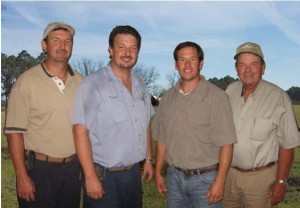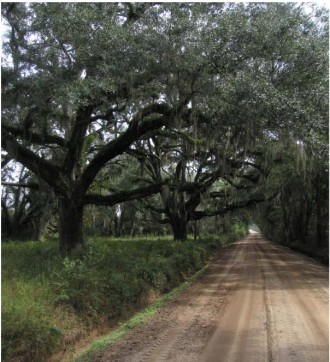Every Friday we will feature one of our easement landowners. These stories are updates on profiles written by Frank McIntosh.
Six generations of Stanleys have worked land in Georgia’s Toombs and Tattnall counties, and another generation is learning to love the land and how to work it.
The Stanley family has been living and farming in the Toombs County area longer than there has been a Toombs County and almost as long as Tattnall has been a county. The history of the Stanleys is their work on the land, including the 1,635-acre tract in Tattnall the family preserved in 2009 with a conservation easement held by the Georgia-Alabama Land Trust.

Six generations: L-R, Bryan, Terry, Vince and R.T. Stanley
“I started out sharecropping with my great uncle,” R.T. Stanley says. It was sharecropping that helped strengthen his determination to own land. “As I was growing up, I always wanted to buy land and own it. It’s in my blood. It’s always better to own it; you never know what will happen when you lease it.” The land in the conservation easement features around two miles of frontage on the Ohoopee River.
“The downturn in the economy was a two-edged sword. It hurt some people, but it helped make this tract available,” says R.T., whose sons Vince, Brian and Tracy joined him in donating the easement. “Buying this tract is the biggest transaction in my life; it’s a big step—a big chance to take.”
All the Stanleys agree that it was a chance worth taking. “It’s just so big and diverse,” Vince says. “There are a couple of hundred acres of longleaf and wiregrass, and we planted another 150 acres of longleaf. There’s a variety of hunting and fishing, and the land is good.”
Good indeed: 43 percent of the property is rated either prime soil or soil of statewide importance. Almost 300 acres are highly desirable for production of sweet Vidalia onions. In addition to growing the onions, the Stanleys now operate Vidalia Valley Farms, which produces Vidalia Valley Onion® products, including salad dressings, barbecue sauce and even a Vidalia Onion Slow Burn Peach Hot Sauce®.
When asked who created the recipes for the sauces, Vince reports that he liked combining his entrepreneurial and culinary abilities. Who created the recipes? Vince says simply, “I did.” His inspiration? “Well, I do like to make money. And they taste real good, too.”

Bottomland along the Ohoopee
The Stanleys’ conservation easement with the Georgia-Alabama Land Trust will ensure that the family will always have a place, not only to continue working the land, but also to gather the family in some of their favorite pursuits. Much of the property is used for hunting and abounds with deer, dove, and turkey. It also features man-made ponds that support healthy populations of bass and white perch.
Vince says, “Working with the Land Trust, we feel like we covered everything. We kept changing the easement around a good bit and got it where it was a win-win. We can continue using the land, mixing in food plots, timber and crops on a lot of the property, but there are over 140 acres of 100-year old bottomlands that will never be touched.”
And even more important to the sixth generation of Stanleys is what the conservation easement means to the seventh generation. “Now, we know our kids will grow up on this land. They love to go out on it with us.”
Vidalia Valley Farms
Stanley Farms
 stitute (CEI) will be presenting diverse learning stations for kids from pre-k to grey. There will be a hay ride, bug hunt, a bird migration game, a 4-H River Kids safety course, and live animals, including reptiles and birds of prey.
stitute (CEI) will be presenting diverse learning stations for kids from pre-k to grey. There will be a hay ride, bug hunt, a bird migration game, a 4-H River Kids safety course, and live animals, including reptiles and birds of prey.










